Porsche's Forgotten Man, Adolf Rosenberger: Dr. Porsche's Jewish Partner, Part One

According to official Porsche lore, the automotive design firm, Dr. Ing. Hc F. Porsche GmbH, was founded in Stuttgart-Zuffenhausen in 1931 by Dr. Ferdinand Porsche and his son-in-law Anton Piëch. The Porsche and Piëch families still control the sports car company and the larger Volkswagen Group that owns it. At that beginning though, there was a third, now forgotten man without whom there would likely not be a Porsche company today.
In fact, without Adolf Rosenberger, there would not have been a Porsche company in the first place.
Adolf Rosenberg was born in Pforzheim, Germany in 1900. His family owned cinemas and their financial success allowed him to be a gentleman racer, one of the more successful in Europe in the 1920s. As a privateer, he had enough success that he was hired as a factory driver and raced in the most famous racecars of his day — like the radically streamlined and mid-engined Benz Tropfenwagen and the Mercedes-Benz SSK.
Rosenberger won the Stuttgart Solitude race and the Kassel Herkules Bergpreis hill climb three years running — 1925 through 1927 — along with the grueling Klausenrennen mountain race those same years. At the Nürburgring’s inaugural race in 1927, he finished second behind the great Rudolf Caracciola, both of them driving supercharged Mercedes SSKs developed by Dr. Porsche.
Adolf Rosenberger at the wheel of the Benz Tropfenwagen streamlined mid-engine racer.
Rosenberger’s racing career had tragedy as well. In the 1926 German Grand Prix at Berlin’s AVUS track, he lost control of his car and crashed into the timekeeper’s shed, killing three people. Rosenberger was hospitalized with a head injury.
That same year, Rosenberger’s met Ferdinand Porsche, Daimler’s technical director. It was also the year that Daimler merged with Benz. Porsche proposed a new, lightweight Mercedes-Benz, but the new company’s directors disapproved. In 1929, he left for Steyr Automobile in Austria.
Dr. Porsche had an outstanding reputation as an engineer and had worked for many leading automakers in Germany and Austria, but it seems that one reason for his many positions of employment was his penchant for telling them what they didn’t want to hear. Perhaps an independent design firm was a better fit.
Also, Porsche didn’t have many options. His position at Steyr was eliminated in a cost cutting move due to the growing worldwide economic depression.
According to Ghislaine Kaes, Porsche’s personal secretary, the engineer had a good reputation — but not much money.
“Porsche didn’t have the financial means at the time for such an establishment. These funds were supplied by Adolf Rosenberg.” Adolf Rosenberger put up 30,000 marks to capitalize the design agency. Dr. Porsche got 80 percent of the stock, Anton Piëch received 10 percent and Rosenberger was allotted the remaining 10 percent. Facilities were rented at Kronenstrasse 24 in Stuttgart.
Adolf Rosenberger (smoking) with his hands on the shoulders of Ferdinand Porsche.
Things were not easy in the early days. They had a contract with Wanderer to develop a people’s car, but the automaker had financial difficulties. A similar contract was made with Zundapp, but that car — the Porsche Type 12 — never made it to production, thus didn’t generate license fees. Many of the design elements of the Type 12, though, would find their way into the first Volkswagen. In a 1966 interview, Rosenberger said that development meetings for the Type 12 usually consisted of Dr. Porsche, designer Karl Rabe and himself.
Once Wanderer-Werke were approached in order to get a design commission, we decided to develop a drawing office in Stuttgart on 24 Kronenstrasse. After this model came a design so-called volkswagen for the Zuendapp-Werke in Nuernberg. This car already had most of the design features of Volkswagens that came later. The discussions about the development and what was required were always between Dr. Porsche and me as co-partner/owner and co-founder of the company, mostly with the input of our chief designer, Karl Rabe.
Porsche Zundapp Type 12
Rosenberger acted as both commercial director and managing director of the Stuttgart engineering firm. His financial and business skills were not his only contributions, however. Rosenberger’s technical experience with the mid-engine Tropfenwagen was of great value as Porsche embarked on designing a 16-cylinder Grand Prix race car for Auto Union with the engine behind the driver.
Benz Tropfenwagen
Rosenberger also accompanied Ferry Porsche when Dr. Porsche dispatched his son in 1931 to evaluate Josef Ganz’ Maikäfer [May beetle] “volkswagen” prototype, considered by many to be a direct influence on Dr. Porsche’s own people’s car.
Ferry Porsche and Adolf Rosenberger test Josef Ganz’ Maikäfer, 1931
According to automotive historian Prof. Peter Kirchberg, the Auto Union racers may have been Rosenberger’s idea in the first place.
Kirchberg believes that Rosenberger also had an influential role in creating Auto Union in 1932, the merger of four German automakers — Audi, DKW, Horch, and Wanderer.
“For me, Rosenberg was the key player in the accomplishment of the merger, that one must say, it is in the time before the Auto Union that the idea — Rosenberger and von Oertzen as members of the Rotary Club gave birth to the idea to push a race car by Porsche — and they succeeded.”
Rosenberger and Wanderer sales manager Baron Klaus von Oertzen were both members of the Berlin Rotary Club and it was there that the idea of a Porsche designed, 16-cylinder race car for Wanderer was born. Wanderer, however, became financially insolvent in 1932, which prompted creating Auto Union. The race car idea survived the bankruptcy and merger. Auto Union wanted the Grand Prix racer built provided that the Porsche agency could find a sponsor.
In 1933, that sponsor was found in the person of Adolf Hitler, newly installed as German chancellor. Hitler saw auto racing as a means of projecting German prowess and power. In February 1933, Hitler gave a speech opening the Berlin auto show and Dr. Porsche sent the soon-to-be-dictator a congratulatory letter, offering his services. A month later, Ferdinand Porsche, Baron von Oertzen, and racer Hans Stuck met with Hitler in the Reich Chancellery. The result was that Porsche and Auto Union were given 300,000 reichsmarks to build a race car.
Later, of course, Hitler’s commission to Porsche for the KdF Volkswagen people’s car would put Dr. Porsche’s company on even better financial footing.
Dr. Porsche and another Adolf.
While all that was going on, Rosenberger began to have concerns about himself being a Jew in Germany and Adolf Hitler, no great judeophile, being in power. Rosenberger brought in his friend Baron Hans von Veyder-Malberg to serve as Managing Director of the design agency and apparently gave nominal control of his shares in the company to Malberg in a strawman deal.
In a 1966 interview, Ghislaine Kaes described the situation.
“Adolf Rosenberger’s position was haunted soon after 1933, as he was Jewish. He must have anticipated this early on, because in January of 1933, he had begun to install a commercial director as his replacement, Hans Baron Veyder-Malberg.”
Though the Grand Prix racer project was good for the young Porsche design bureau’s reputation, it didn’t generate any revenue for the company early on. There was also the depression. To keep the company afloat before Hitler’s sponsorship of the Auto Union racecar came through, Rosenberger made a stockholder loan of 80,000 reichsmarks to the firm. That means that not only did Rosenberger provide the startup capital for the Porsche company, he kept it in business for the first two years of its existence.
In that 1966 interview, Ghislaine Kaes said that Rosenberger left Germany for Paris and then to Switzerland.
“Adolf Rosenberg was prosecuted under several pretenses. One day, in the clutches of the Gestapo, Rosenberger was just able to escape and this left him in Paris.”
He worked as Porsche’s sales representative in Switzerland and France. In the summer of 1935, however, Rosenberger returned to Germany.
After the war, Rosenberger filed for restitution in a German proceeding, saying that he had to cede his 10-percent share in the company to Ferry Porsche, Dr. Porsche’s son, in July of 1935 for just 3,000 marks in a year when Rosenberger’s share of the company’s 100,000 reichsmark profits alone should have been more than three times that amount. In 1949, Rosenberger sought a restitution payment of 180,000 marks for the true value of his stock and the loan he had made to the firm.
In September of 1935, after he had returned to Germany, the Gestapo arrested Rosenberger for “racial shame.” In other words, he had an “Aryan” German girlfriend. After about three weeks in the Kislau concentration camp, where the treatment was apparently brutal enough that it permanently affected his health, Rosenberger was released and made to pay 53 reichsmarks for the cost of his “protective custody.”
In 1945, Ferry Porsche, Dr. Porsche’s son said that the Porsche and Piech families had interceded on behalf of Rosenberger, to get him released. However, Rosenberger maintained until his death that the only help he got was from Baron von Veyder-Malberg, who bailed him out.
Once he was released from the Kislau prison camp, Rosenberger fled Germany, not to return until after World War II. He ended up in America in the late 1930s, first visiting in 1936.
In Part Two, we’ll look at Adolf Rosenberger’s life after Porsche, how he tried to start a new life under a new name in California, and his attempts to get restitution and recognition for his role in starting and running the Porsche company.
Special thanks to Jennifer Archibald for translating some of the German quotations.
[Image: Auto Union Typ C, Lothar Spurzem/Wikimedia (CC BY-SA 2.0)]
Ronnie Schreiber edits Cars In Depth, a realistic perspective on cars & car culture and the original 3D car site.

Ronnie Schreiber edits Cars In Depth, the original 3D car site.
More by Ronnie Schreiber
Latest Car Reviews
Read moreLatest Product Reviews
Read moreRecent Comments
- Cprescott I have watched a series of teardown videos by Munro and Associates (sycophants to Tesla) and cannot believe the hoodwinking that was done with this POS. There was no way it was ever going to sell the golf cart with a bed for the price they said. I cannot believe all of the space those motors take up - so huge and expensive. And the battery pack is the size of Rhode Island!
- Rick T. That's the way the (Milano) cookie crumbles.
- ChristianWimmer My requirements are simple: I love driving fast (Autobahn) and I want a relatively generous and stable range while using creature comforts. No EV on the market can satisfy this requirement, hence I am not interested in one.
- Cprescott Jeep has become fool's gold - thinking they can move this brand upmarket and charge outrageous prices without regard to keeping track of market conditions.
- Chiefmonkey Did these have the same security/theft problem that other Kias have? lol













































Comments
Join the conversation
I realise that this is not a Porsche-generic website, but I'm obliged to mention that Porsche folks know all about Adolf Rosenberger from my various books about Porsche history. He's not exactly secret or forgotten. That being said, I do plan to write more fully about Rosenberger in a future book. And praise is due here for the very good photos, many of which I haven't seen before. Karl Ludvigsen
I'm just blown away. Blown away by the piece that Ronnie wrote, blown away by the participation of Karl Ludvigsen in the comments, and blown away by how the bigot was handled. I'm much too much of a hothead to deal with someone like that in the calm, intelligent way in which the B&B (and Ronnie) has. I love this site, and I love its contributors, both the writers and commenters. Thanks to all for this little piece of the internet that proves that the world hasn't turned into "Idiocracy" quite yet.